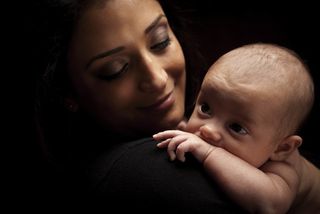Why Does It Take 9 Months for a Baby to Grow
Why Pregnancy Really Lasts ix Months

Human babies are built-in helpless and needy, a fact that anthropologists have long explained past pointing to the size of the female person pelvis. If babies were born with bigger brains, the theory goes, they'd get stuck in the nascence canal. Instead, they terminate gestating before they abound too large, resulting in completely dependent newborns.
Only the story may not exist so simple, new inquiry finds. A study published today (Aug. 27) argues that it's non the size of mom's pelvis that determines when baby is born, but her metabolism.
"There is not a unique pelvic constraint on gestation length and baby size," study researcher Holly Dunsworth, an anthropologist at the University of Rhode Isle, told LiveScience. "At that place is a certain capacity a mother has metabolically, and once that capacity is reached, the infant is born."
Baby heads and pelvic width
Human being babies are born underdeveloped compared with other primates: Our brains are less than 30 percentage their adult size at birth, compared with around 40 pct for chimpanzees, our closest living ape relative. In fact, it would take a gestation length of 18 to 21 months instead of nine months for human being babies' brains to reach that level of evolution, co-ordinate to zoologist Adolf Portmann's book "A Zoologist Looks at Humankind" (Columbia University Printing, 1990).
The problem of fitting babe's caput through mom's pelvis is known as the "obstetrical dilemma." Anthropologists accept theorized that development has made a trade-off betwixt large baby brains and the narrow pelvises needed for bipedal walking, resulting in babies born before than the ideal.
But Dunsworth's math suggests a dissimilar interpretation. In fact, she said, when you take trunk size into account, humans aren't cutting gestation brusk at all. After decision-making for body size, homo pregnancies are second in length only to orangutans' and 37 days longer, not shorter, than gorilla and chimpanzee pregnancies, Dunsworth and her colleagues report in the journal Proceedings of the National Academy of Sciences.
"We're really gestating longer than you lot would predict," Dunsworth said.
Homo mothers likewise invest a lot of energy in their babies in the womb. The researchers found that human baby brains are 47 per centum larger than babe gorilla brains, the primate with the next-largest infants. Human newborns are besides twice the size of gorilla newborns. Fifty-fifty when decision-making for maternal torso size, human babies are larger than expected. In other words, humans aren't growing our babies smaller than average; we're super-sizing them. [Procreation Station: 11 Odd Animal Pregnancies]
Hips and energy
Next, Dunsworth and her colleagues turned to the other side of the dilemma: Mom's hips. Again, they establish little evidence to back up the assumptions of the obstetrical dilemma. Women's wider hips are not less free energy-efficient than men's narrower pelvises, the researchers calculated.
"Within the normal range of variation in women and men, walking and running are not compromised by a wider pelvis," Dunsworth said.
What's more, to get human brains upward to the chimpanzee level of 40 percent of adult size, the pelvis would just have to widen nearly 1.18 inches (three centimeters), well inside the normal range of variation of humans today, the researchers found. This actress space wouldn't add any extra energy burden, they wrote.
So why are babies born after nine months of gestation and not another point? Dunsworth and her colleagues found that metabolism may hold the reply. By six months of pregnancy, women expend twice their usual energy keeping bones metabolic processes going, a burden that but gets greater equally the fetus gets larger. The typical maximum metabolic charge per unit humans can sustain is between two times and 2.five times average (with some exceptions such as professional person cyclists). That means the female body may simply not exist able to bike through enough energy to go along a pregnancy going more than than ix months. [8 Weird Changes That Happen During Pregnancy]
A new story
The findings complicate the "fairly elementary" story of baby encephalon size being prepare by mom's pelvic size, said John Fleagle, an evolutionary biologist at Stony Brook University Schoolhouse of Medicine in New York.
"This is the nearly thorough and thoughtful consideration of this effect that anyone'due south ever washed," Fleagle, who was not involved in the written report, told LiveScience.
The findings basically switch around the supposition that the demands of walking and running on mom'due south pelvis determine babe'due south caput size and suggest that instead, mom'due south metabolism sets the pregnancy length and baby size and the pelvis adapts to fit, Fleagle said. It's also possible that earlier the invention of agriculture, humans didn't take the energy to abound babies quite so large, meaning labor and delivery may not have been equally much trouble tens of thousands of years agone as they are today.
Pelvic and head size still play a role in the birth process, noted Wenda Trevathan, a biological anthropologist at New Mexico Land University who studies childbirth and was not involved in the inquiry. Shoulder size and shape may also influence how babies emerge from the nascence canal, all pregnant that unlike other animals, humans are better off when they have help at birth.
Ultimately, Fleagle said, information technology may be a mistake to think of helpless babies every bit an evolutionary negative. Existence born before the brain is set allows human offspring to learn from experience.
"The helpless baby is a babe that grows upwardly in an environment that it has to deal with," he said.
Follow Stephanie Pappas on Twitter @sipappas or LiveScience @livescience . We're also on Facebook & Google+ .
rodriguezwairespleet.blogspot.com
Source: https://www.livescience.com/22715-pregnancy-length-baby-size.html

0 Response to "Why Does It Take 9 Months for a Baby to Grow"
إرسال تعليق